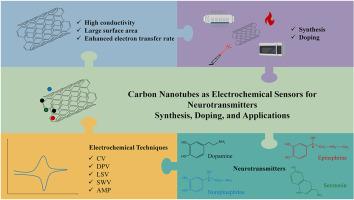Carbon nanotubes as electrochemical sensors for neurotransmitters: Synthesis, doping, and applications
IF 11.6
2区 材料科学
Q1 CHEMISTRY, PHYSICAL
引用次数: 0
Abstract
Carbon nanotubes (CNTs) have gained widespread attention in recent years as promising materials for electrochemical sensing given their unique electronic, mechanical, and surface properties. Among various applications, CNTs have been utilized in the modification of electrodes for electrochemical sensing of biomolecules, including neurotransmitters. Catecholamines, including dopamine (DA), epinephrine (EPN), norepinephrine (NEPN), and serotonin (SE) constitute key neurotransmitters, which contribute to various physiological processes. Imbalances in catecholamine levels are associated with neurodegenerative diseases, underscoring the need for rapid and accurate determination of these neurotransmitters in biological samples. This review article presents the main synthetic routes for CNTs, along with doping strategies, emphasizing their impact on CNTs’ properties. We summarize the recent progress in the integration of CNTs-modified electrodes for neurotransmitters detection in terms of sensitivity, selectivity, and clinical sample analysis. Furthermore, we discuss ongoing challenges and future perspectives regarding the optimization of CNTs-modified electrodes applied in real-time diagnostic platforms, thus enabling effective monitoring of neurotransmitter levels in complex biological systems.

碳纳米管作为神经递质的电化学传感器:合成、掺杂和应用
碳纳米管(Carbon nanotubes, CNTs)由于其独特的电子、机械和表面性能,近年来作为电化学传感材料受到了广泛的关注。在各种应用中,碳纳米管已被用于修饰电极,用于生物分子的电化学传感,包括神经递质。儿茶酚胺,包括多巴胺(DA)、肾上腺素(EPN)、去甲肾上腺素(NEPN)和血清素(SE)构成了关键的神经递质,参与各种生理过程。儿茶酚胺水平失衡与神经退行性疾病有关,因此需要快速准确地测定生物样品中的这些神经递质。本文综述了碳纳米管的主要合成途径以及掺杂策略,重点介绍了它们对碳纳米管性能的影响。我们总结了碳纳米管修饰电极在神经递质检测的敏感性、选择性和临床样品分析方面的最新进展。此外,我们讨论了碳纳米管修饰电极在实时诊断平台中的优化所面临的挑战和未来的前景,从而能够有效地监测复杂生物系统中的神经递质水平。
本文章由计算机程序翻译,如有差异,请以英文原文为准。
求助全文
约1分钟内获得全文
求助全文
来源期刊

Carbon
工程技术-材料科学:综合
CiteScore
20.80
自引率
7.30%
发文量
0
审稿时长
23 days
期刊介绍:
The journal Carbon is an international multidisciplinary forum for communicating scientific advances in the field of carbon materials. It reports new findings related to the formation, structure, properties, behaviors, and technological applications of carbons. Carbons are a broad class of ordered or disordered solid phases composed primarily of elemental carbon, including but not limited to carbon black, carbon fibers and filaments, carbon nanotubes, diamond and diamond-like carbon, fullerenes, glassy carbon, graphite, graphene, graphene-oxide, porous carbons, pyrolytic carbon, and other sp2 and non-sp2 hybridized carbon systems. Carbon is the companion title to the open access journal Carbon Trends. Relevant application areas for carbon materials include biology and medicine, catalysis, electronic, optoelectronic, spintronic, high-frequency, and photonic devices, energy storage and conversion systems, environmental applications and water treatment, smart materials and systems, and structural and thermal applications.
 求助内容:
求助内容: 应助结果提醒方式:
应助结果提醒方式:


